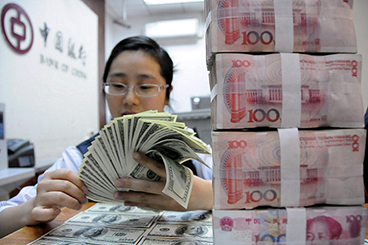
Russia and China Challenge Dollar Domination
By F. William Engdahl
20 December 2017
The Russian government has recently announced it will issue nearly $1 billion equivalent in state bonds, but denominated not in US dollars as is mostly the case. Rather it will be the first sale of Russian bonds in China’s yuan. While $1 billion may not sound like much when compared with the Peoples’ Bank of China total holdings of US Government debt of more than $1 trillion or to the US Federal debt today of over $20 trillion, it’s significance lies beyond the nominal amount. It’s a test run by both governments of the potential for state financing of infrastructure and other projects independent of dollar risk from such events as US Treasury financial sanctions . .
Russian Debt and China Yuan
Since the August 1998 sovereign default triggered by the West, Russian state finances have been prudent to almost a fault. The size of the national government debt is the lowest of any major industrial country, a mere 10.6% of GDP for the current year. This has enabled Russia to withstand the US financial warfare sanctions imposed since 2014, and forced the country to turn elsewhere for their financial stability. That “elsewhere” is increasingly called the Peoples’ Republic of China.
Now the Russian Ministry of Finance is reportedly planning the first sale of Russian debt in the form of bonds denominated in Chinese yuan currency. The size of the first offering, a testing of the market, will be 6 billion yuan or just under $1 billion. The sale is being organized by the state-owned Russian Gazprombank, the Bank of China Ltd., and China’s largest state bank, Industrial & Commercial Bank of China. The move is being accelerated by reports that the US Treasury is examining potential consequences of extending penalties, until now concentrated on Russian oil and gas projects, to include Russian sovereign debt in its sanctions warfare. The new yuan bond will be traded on the Moscow Exchange and will aim to sell to mainland Chinese investors as well as international and Russian borrowers at attractive interest rates.
Western sanctions or threats of sanctions are forcing Russia and China to cooperate more strategically on what is becoming the seed of a genuine alternative to the dollar system. The Russian yuan debt offerings will also give a significant boost to China’s desire to build the yuan as an accepted international currency.
China Petro-Yuan
The steps to begin issuing Russian state debt in yuan are paralleled by another major development towards broader international yuan acceptance vis a vis the US dollar. On December 13, Chinese regulators completed final testing in preparation for launch of not a dollar-backed, but rather, a yuan-backed oil futures contract to be traded on the Shanghai Futures Exchange. The implications are potentially large.
China is the world’s largest oil importing country. Control of financial oil futures markets until now has been the tightly-guarded province of Wall Street banks and the New York, London and other futures exchanges they control. Emergence of Shanghai as a major yuan-based oil futures center could significantly weaken dollar domination of oil trade.
Since the 1970’s oil shock and the 400% rise in the oil price from OPEC countries, Washington has maintained a strict regime in which the world’s most valuable commodity, oil, would be traded in US dollars alone. In December 1974, the US Treasury signed a secret agreement in Riyadh with the Saudi Arabian Monetary Agency, “to establish a new relationship through the Federal Reserve Bank of New York with the US Treasury borrowing operation” to buy US government debt with surplus petrodollars.
The Saudis agreed to enforce OPEC dollar-only oil sales in return for US sales of advanced military equipment (purchased for dollars of course) and a guarantee of protection from possible Israeli attack. This was the beginning of what then-US Secretary of State Henry Kissinger called recycling the petro-dollar. To the present, only two oil export country leaders, Iraq’s Saddam Hussein and Libya’s Qaddafi, have tried to change the system and sell oil for euros or gold dinars. Now China is challenging the petro-dollar system in a different way with the petro-yuan.
The difference between Saddam Hussein or Qaddafi is that far more influential countries, Russia and now Iran, with China’s implicit support, are cooperating to avoid the dollar out of necessity forced by US pressure. That is a far stronger challenge to the US dollar than Iraq or Libya could ever manage.
The China yuan oil futures contract now will allow China’s trading partners to pay with gold or to convert yuan into gold without the necessity to keep money in Chinese assets or turn it into US dollars. Oil exporters such as Russia or Iran or Venezuela—all targets of US sanctions—can avoid those US sanctions by avoiding oil trades in dollars now. This past September Venezuela responded to US sanctions by ordering the state oil company and traders to make oil sale contracts into euro and not to pay or be paid in US dollars any longer.
Gold for oil?
The Shanghai International Energy Exchange will soon launch their crude-oil futures contract denominated in yuan. The Shanghai International Energy Exchange futures contract will streamline and solidify the process of selling oil to China for yuan that Russia began after sanctions in 2014. This will also allow other oil producers around the world to sell their oil for yuan instead of dollars. The crude oil futures contract will be the first commodity contract in China open to foreign investment funds, trading houses, and oil firms. The circumvention of US dollar trade could allow oil exporters such as Russia and Iran, for example, to bypass US sanctions.
To make the offer more attractive, China has linked the crude-oil futures contract with the option to efficiently convert yuan into physical gold through gold exchanges in Shanghai and Hong Kong. According to Wang Zhimin, director of the Center for Globalization and Modernization at China’s Institute of Foreign Economy and Trade, the possibility of converting the yuan oil futures into gold will give the Chinese futures a competitive advantage over Brent and West Texas Intermediate benchmarks.
Now Russia or Iran or other oil producers are in a position to sell oil to China for yuan or rubles, bypassing the dollar entirely. The shift is about to take place in the coming weeks as the yuan oil futures contract is officially launched. Further in October China and Russia launched what is called a payment versus payment (PVP) system for Chinese yuan and Russian ruble transactions that will reduce settlement risk for oil and other trades.
Already reportedly Russian oil and gas sales to China are being conducted in Ruble and Yuan and since the foolish US effort to isolate Qatar in the Persian Gulf, Qatar, a major LNG gas supplier to China has switched to pricing in yuan. Pressure is growing that at some point Saudi Arabia breaks its 1974 pact with Washington and sells its oil to China also for yuan.
Iran to Join EEU
A new element is about to be added to the growing cooperation across Eurasia centered around China and Russia, namely Iran. According to Behrouz Hassanolfat of Iran’s Trade Promotion Organization, in a statement carried on Iranian state-owned Press-TV, as early as February, 2018 Iran is set to become a member of Russia’s Eurasian Economic Union (EEU). Presently the EEU, created in 2015, includes Russia, Kazakhstan, Belarus, Armenia and Kyrgyzstan to create a large zone for free transit of goods, services, capital and workers among member states. Presently the EEU is a market of 183 million people. Addition of Iran with its more than 80 million citizens would give a major boost to the economies of the EEU and to its economic importance, creating a common market of more than 263 million, with skilled labor, engineers, scientists and industrial know-how.
Iran has already announced, in face of escalating threats from Washington, that it seeks ways to sell its oil for non-dollar currencies. Integration into the EEU could bring a solution to this as Iran, Russia and China inevitably draw closer in face of relentless US pressures on all three.
Increasingly in proportion to the pressure from the West the nations of Eurasia are developing modes of growing their economies independent of US Treasury financial sanctions. In retrospect, it’s likely that those US sanctions will be seen as one of the more stupid attempts of Washington to dominate the economies of Eurasia.
F. William Engdahl is strategic risk consultant and lecturer, he holds a degree in politics from Princeton University and is a best-selling author on oil and geopolitics, exclusively for the online magazine “New Eastern Outlook”
